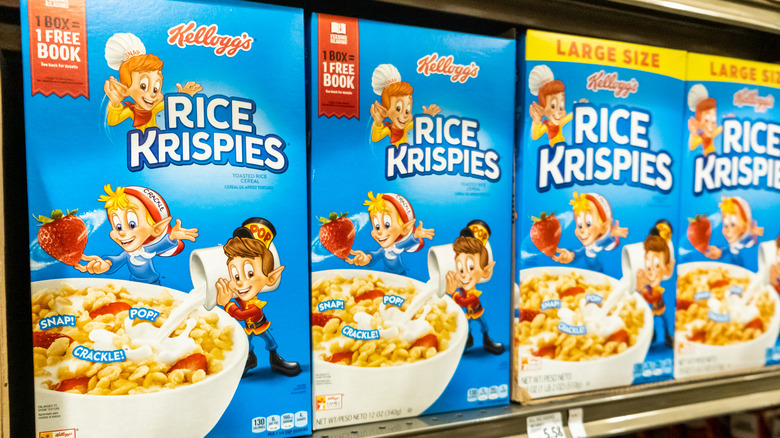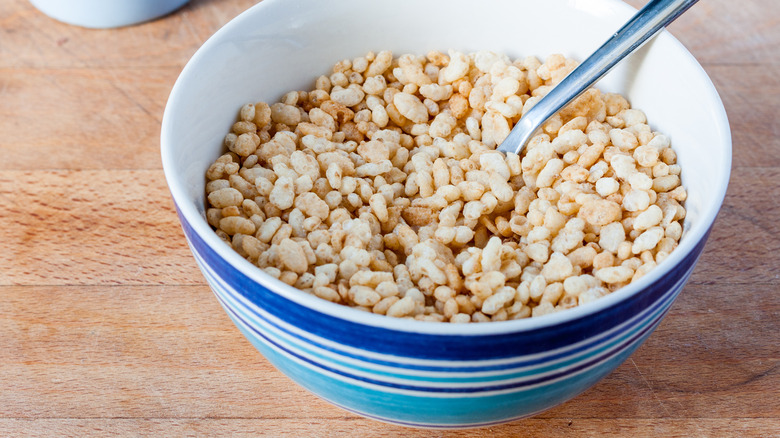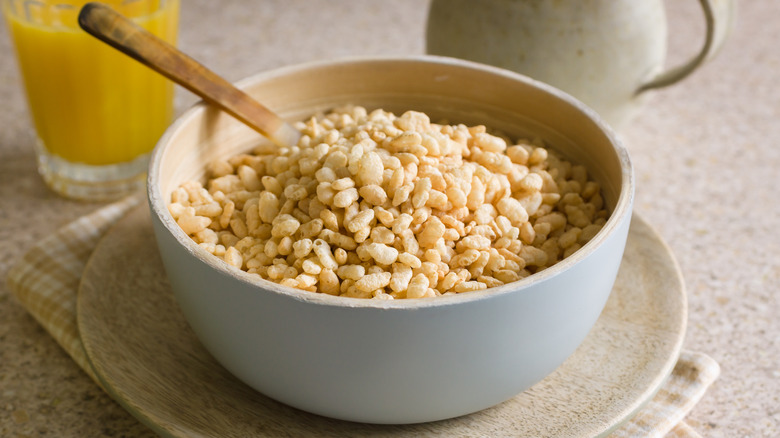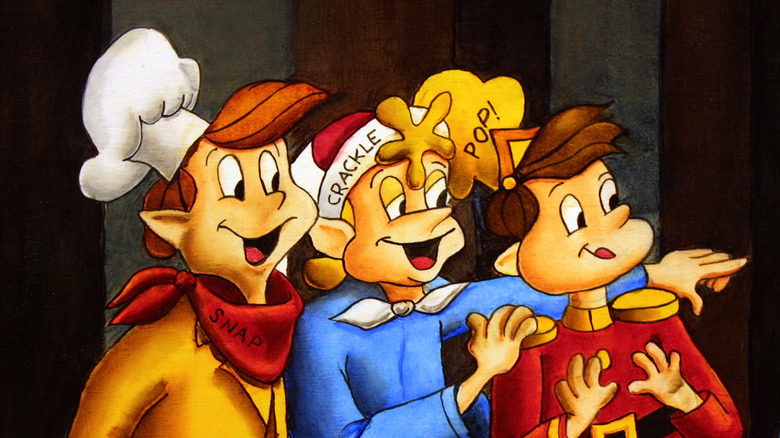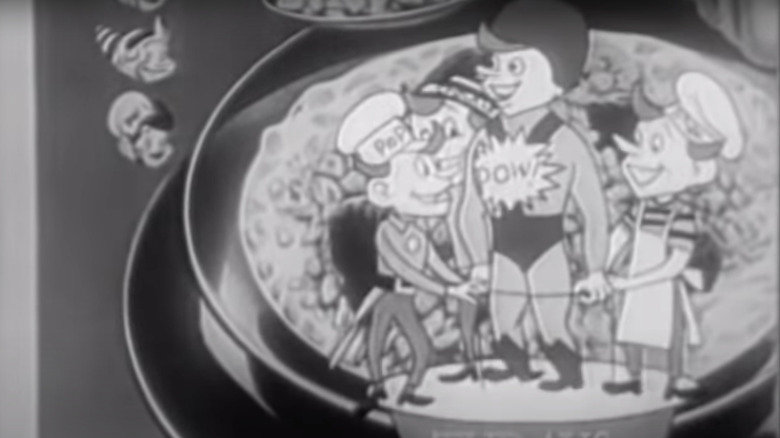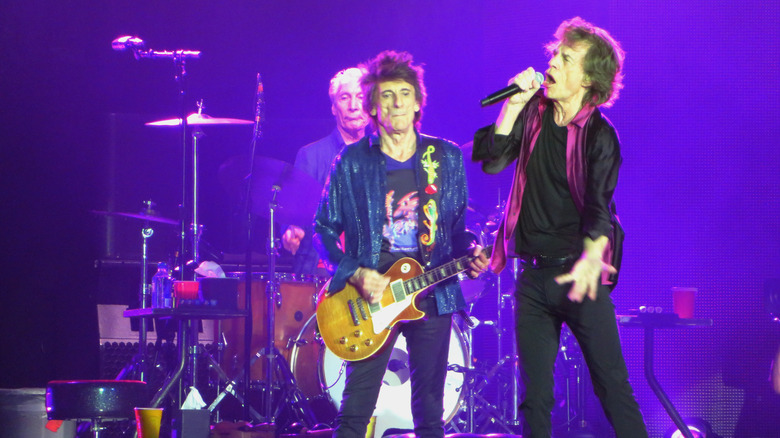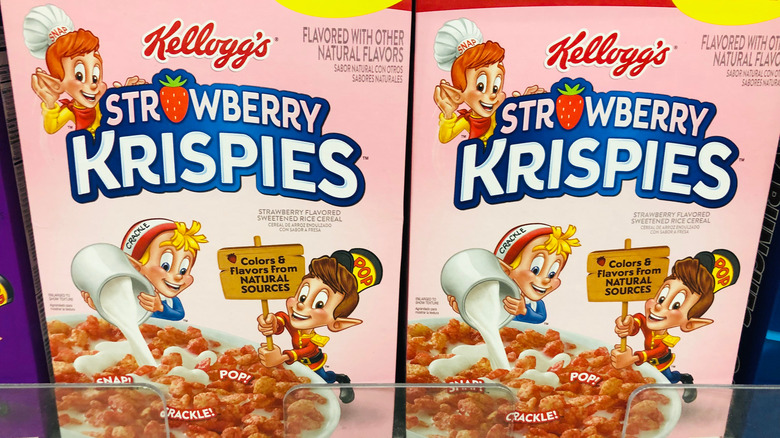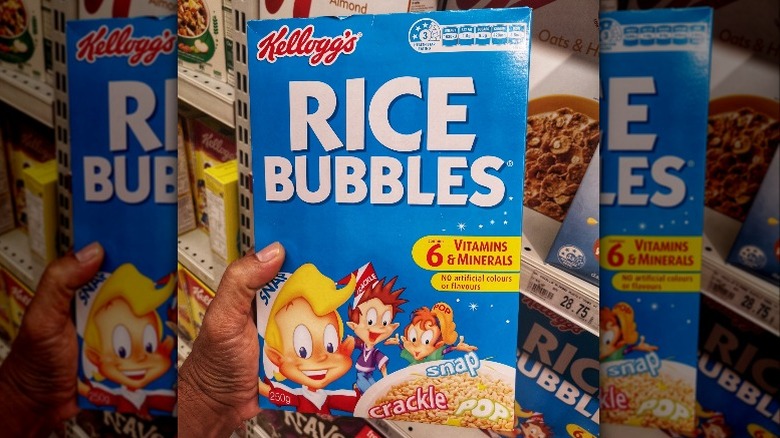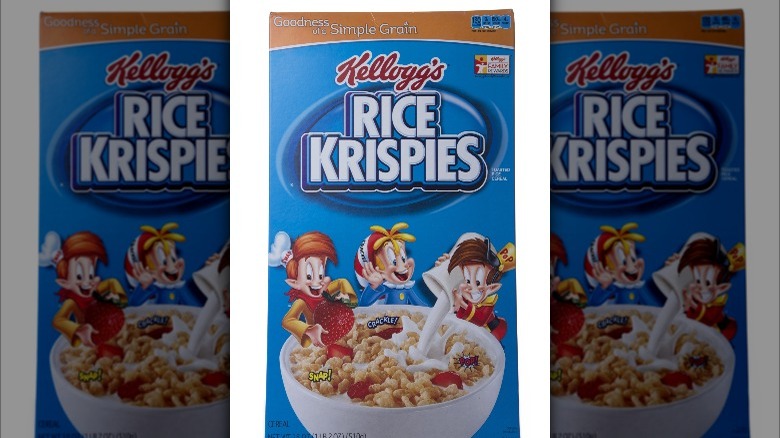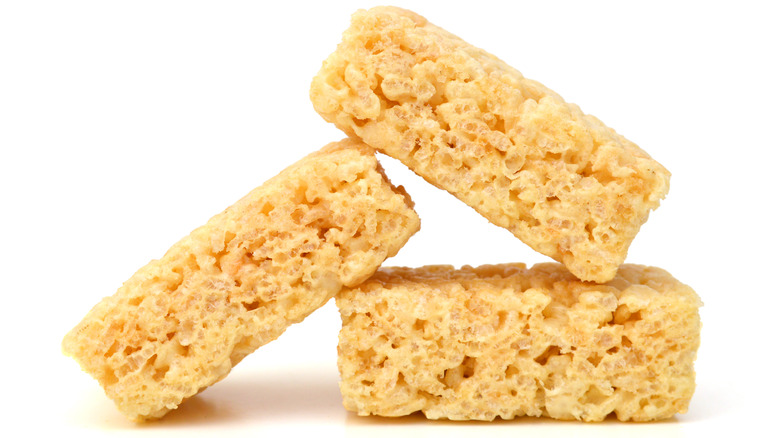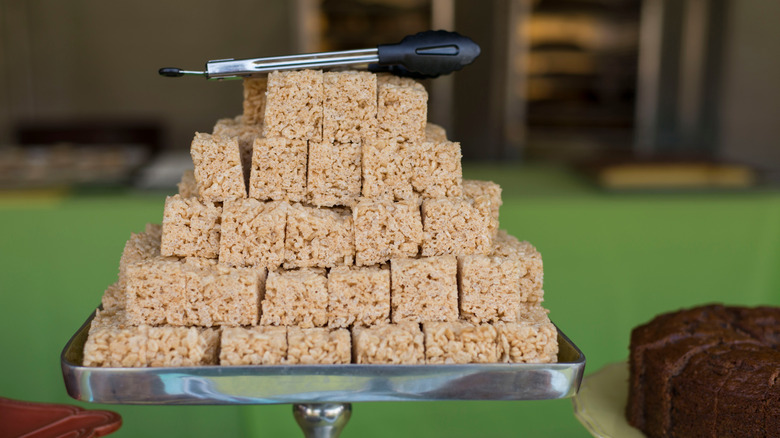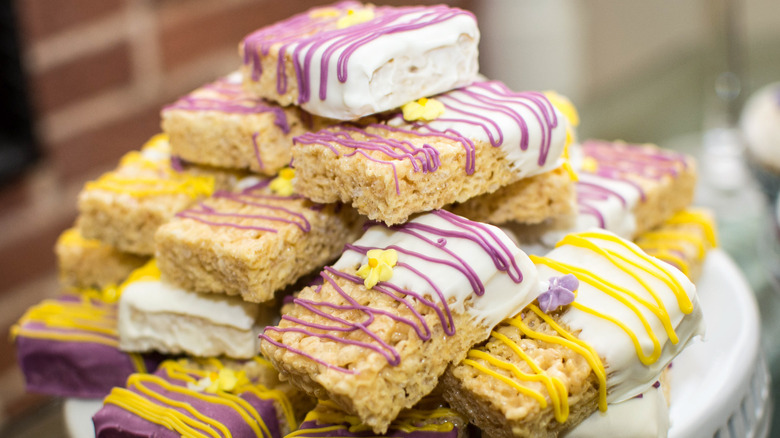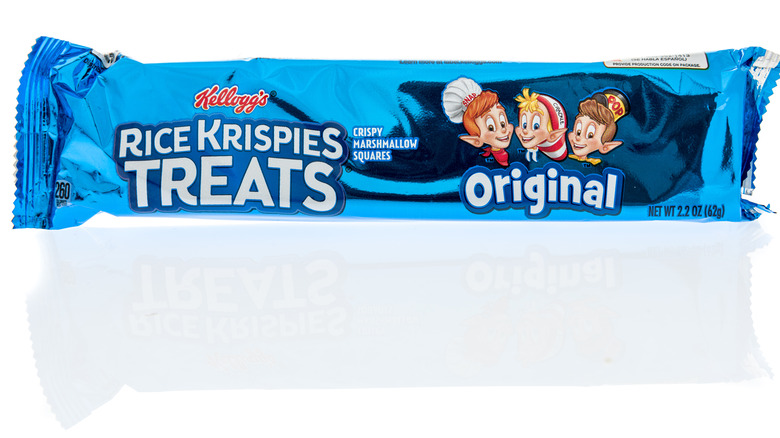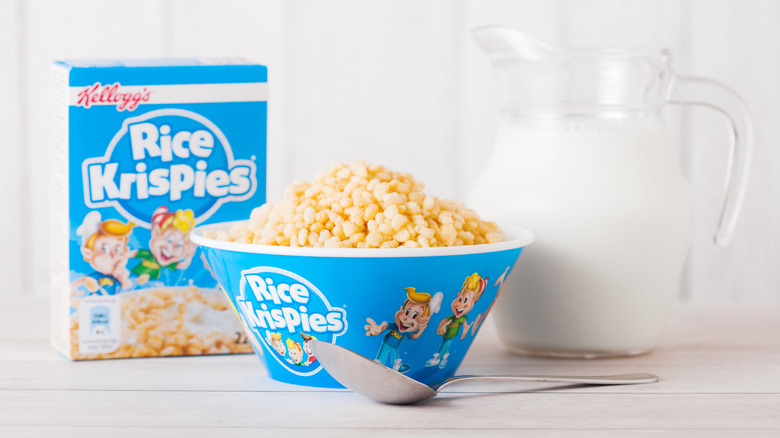The Untold Truth Of Rice Krispies
Rice Krispies are a stalwart childhood staple: a cereal beloved for its simple, mild flavor, adorable mascots, and, of course, for the noise it makes the second milk is introduced to the bowl. But did you know that Rice Krispies were once promoted by the Rolling Stones? Or that there's a long-forgotten fourth mascot who drove a spaceship and has since disappeared into oblivion?
Rice Krispies are also at the heart of one of our favorite homemade treats, something simple enough for kids to make almost on their own. Rice Krispies treats have also spurred some competitive record-breaking. They have a long history too, beginning with a fundraiser organized by Camp Fire Girls in 1939 and extending into the present day with TikTok fame.
For these and other facts about this beloved breakfast cereal, look no further: We're here with everything you didn't even know you needed to know about Kellogg's Rice Krispies.
Rice Krispies were first launched by Kellogg's in the 20s -- and remain beloved to this day
Rice Krispies are the very definition of an oldie but a goodie: The puffed rice cereal was first launched by Kellogg's back in 1928. In a press release shared by the company on the 80th anniversary of the cereal, the outlet reports, the R&D team at Kellogg's was already hard at work on a puffed rice cereal in 1927. When they presented their idea to Kellogg's founder W.K. Kellogg, he ostensibly quipped, "You've got something there!"
And they did: The cereal remains a stalwart of the breakfast aisle, with $136.7 million in sales in 2018, according to Kiplinger.
"We're proud that Rice Krispies cereal has been a part of the childhood of so many generations of consumers," Mark Baynes, chief marketing officer for Kellogg's, said in the anniversary press release. "The Rice Krispies brand continues to grow and evolve, yet it's still the same cereal that parents and grandparents have loved since they were kids."
That noise Rice Krispies make comes from air
One of the first things most people notice about Rice Krispies is the distinctive noise they make when milk is added to the bowl. It's no surprise that, according to Kellogg's, Rice Krispies were initially marketed as "The Talking Cereal" back in 1928.
LiveScience, citing research conducted by food scientist Ted Labuza, reports that the noise Rice Krispies make comes from their physical structure. Rice Krispies are made by cooking rice at a high temperature. This process makes the rice expand (or puff), creating pockets of air divided by bonded starch molecules. This causes the cereal to behave like a piece of glass. Liquid (in this case, milk) puts pressure on the air pockets, pushing the air up against the thin walls of the pocket, shattering it. And it's that shattering that makes the distinctive snap, crackle, and pop noises Rice Krispies are known for.
Mascots Snap, Crackle, and Pop are a huge part of Rice Krispies' brand identity
Soon after the arrival of the "Talking Cereal" marketing moniker came that oh-so-essential element of any American breakfast cereal's advertising: the mascot. Or mascots, in this case.
The elf trio of Snap, Crackle, and Pop was first introduced in 1932, according to a Kellogg's press release. According to one 2002 poll cited by Scientific American, Americans are more likely to be able to name the mascots than they are Supreme Court justices — slightly embarrassing proof of their pervasiveness in our shared cultural consciousness.
According to Kellogg's, Snap, Crackle, and Pop each boast their own individual personalities. Snap is the eldest and the leader, Crackle is the middle child, and Pop is the clumsy, mischievous, joke-loving youngest. Each wears a distinctive hat (chef's hat, beanie, and band leader's hat, respectively) and wears his name distinctively on his clothing. Today, according to Reader's Digest, the mascots represent the longest-running marketing campaign at Kellogg's.
There was once a fourth elf named Pow
Snap, Crackle, and Pop are an iconic trio — so it may surprise you to learn that there used to be a fourth member of the team known as Pow.
Pow, according to Reader's Digest, appeared in two commercials in the 1950s. The ads said that Pow wasn't a brother but rather a family friend. And the differences between Pow and the more familiar trio don't end there. Unlike Snap, Crackle, and Pop, Pow's name wasn't linked to the noise the cereal makes, but rather to the nutritional "pow(-er)" of the cereal's whole grains. And perhaps the most important distinction? Pow didn't wear an elf outfit but rather a spacesuit.
Space-themed characters were fairly common in media at the time, according to Tim Hollis, author of "Part of a Complete Breakfast: Cereal Characters of the Baby Boom Era." Hollis tells Smithsonian Magazine that "at that particular time, everything was space-oriented."
Pow's tenure as a mascot was short-lived and Kellogg's told the Smithsonian that "He was never considered an official character."
The Rolling Stones recorded an ad campaign for Rice Krispies in the '60s
Snap, Crackle, Pop, and Pow weren't the only folks who appeared in advertising for Rice Krispies. The cereal once had very famous support from none other than the Rolling Stones.
The rock band appeared in a 1963 spot for the cereal, which, according to Playback, was a play on popular TV show Jukebox Jury. The spot included Mick Jagger crowing in his highly recognizable voice, "Wake up in the morning, there's a Snap around the place, wake up in the morning, there's a Crackle in your face, wake up in the morning, there's a Pop that really says this is for you!" The audience goes wild, declaring the song a "hit."
According to The New Yorker, the commercial shows the band's penchant for blending music and commerce. It turns out Rice Krispies are a pretty rock-and-roll way to start the day.
Other Rice Krispies flavors like vanilla and strawberry were once available
Original Rice Krispies are not the most flavorful of breakfast cereals, especially when you compare them with the fruity alternatives they share shelf space with. If you want more flavor (and sugar), you can always try Cocoa Krispies, Frosted Krispies, or Cinnamon Sugar Krispies (via Kellogg's).
There have also been other flavor experiments in the past. According to Mr. Breakfast, in the '80s, a fruit-flavored variety dubbed Fruity Marshmallow Krispies hit stores. With a bright green box helping it stand out from the blue traditional version, this frosted cereal contained fruit-flavored marshmallow bits flavored with orange, lemon, raspberry, and grape. The cereal wasn't a huge hit, as consumers found the cereal too strong in flavor and too fruity. It was slowly removed from distribution in the 90s.
This fruity alternative is not the only version of Rice Krispies to deviate from tradition. Vanilla Rice Krispies are still available in some markets like New Zealand, and Strawberry Krispies can be found in the UK, according to The Sun. The U.S. once had fruity options like Berry Krispies and Rice Krispies with Real Strawberries, according to Kellogg's.
Rice Krispies are sold under other names abroad
Rice Krispies don't just offer other flavors abroad. They are also sold under different names. (And we're not talking about off-brand Rice Pops or Crispy Rice.) In Australia, Kellogg's markets its cereal, not as Rice Krispies, but as Rice Bubbles.
And that's not the only linguistic change that gets made to this breakfast favorite. Notably, the onomatopoeic names of Snap, Crackle, and Pop must be translated in order to be meaningful to natives of other countries, something that Translate Media notes is a pervasive and sometimes surprising element of translation and adaptation.
According to Scientific American, the beloved elf mascots are known as Riks, Raks, and Roks in Finnish; Piff, Paff, and Puff in Swedish, Pim, Pum, and Pam in Spanish, and Knisper, Knasper, and Knusper in German. In Belgium, meanwhile, according to Metro, they're known as Pif, Paf, and Pof, while in South Africa, they're dubbed Knap, Knaetter, and Knak.
In 2010, Kellogg's came under fire for exaggerating the cereal's health benefits
Kellogg's has often based its marketing not just on the sound Rice Krispies make but also on their health benefits — think of Pow's mission to highlight the cereal's nutritional power (via Smithsonian Magazine). But in 2010, Kellogg's came under fire for what the Federal Trade Commission ultimately decided were misleading health claims linked to Rice Krispies' purported immune benefits. The product's box claimed that Rice Krispies "now helps support your child's immunity" with "25 percent Daily Value of Antioxidants and Nutrients – Vitamins A, B, C, and E."
The resulting order from the FTC, prohibited the company from making health claims regarding its products unless these claims were supported by science. According to NUTRA, the company was ordered to pay $5 million in settlement fees after a resulting class-action lawsuit. This followed another incident in which Kellogg's got in hot water for claiming that Frosted Mini-Wheats were clinically proven to improve attentiveness in children.
The Rice Krispies treat was invented by a Kellogg's recipe tester
Perhaps one of the most famous uses of Rice Krispies cereal is in Rice Krispies treats — a dessert that was the brainchild of one Mildred Day, a one-time recipe tester for Kellogg's, according to the Des Moines Register. In 1939, Day first developed the recipe she was then calling Marshmallow Squares, but it wasn't until Kellogg's was contacted by the Kansas City Camp Fire Girls that the recipe truly took off.
In response to calls for ideas for a fundraiser, Day cooked up batch after batch of the treats over the course of two weeks on a grueling schedule of what she told her daughter were 16-hour days. Camp Fire Girls then sold them door to door (much like how their counterparts, the Girl Scouts, sell cookies). The treats were a hit, and by 1941, the recipe had begun appearing on the back of Rice Krispies cereal boxes.
The biggest Rice Krispies treat in the world was made in Wisconsin in 2015
A relatively simple recipe, Rice Krispies treats are easy to make for even the littlest home cooks. In fact, the Battle Creek Enquirer says the recipe's simplicity may be what makes it a popular Guinness World Records challenge.
One of the largest-ever Rice Krispies treats was made in 1997 at Michigan State University as part of a fundraiser for the campus domestic violence shelter. It measured 4 by 8 by 5 feet, with a final weight of a whopping 2,260 pounds. It made an appearance in an on-campus parade before it was consumed.
In the time since, however, several larger treats have been made, including one in Wisconsin in 2015. This treat, which was cooked by a group of students from the University of Wisconsin – Madison, weighed a whopping 11,327 pounds, blowing the previous giant treats out of the water.
Chefs love creating artisanal and gourmet versions of Rice Krispies treats
In addition to being a popular subject of world record attempts, Rice Krispies treats are beloved for their ability to be customized by even the most fine-dining-minded of chefs. British celebrity chef Josh Eggleton contributed a recipe featuring dark chocolate, orange, and Pop Rocks to Great British Chefs, while David Shim of New York's Cote kept things simple in the recipe he shared with Insider. On Instagram, Sarah Crawford of Broma Bakery glams hers up with peanut butter and Oreo cookies. You can even change up the cereal you use: Fruity Pebbles lend a bit of fruity flavor and color to the traditional treat.
Kellogg's encourages people to customize their treats at home. "Rice Krispies remains one of America's most beloved cereals," Blair Price, senior manager of brand marketing for Rice Krispies, told the Battle Creek Enquirer. "The brand has focused on using Rice Krispies for unique recipes and is currently airing a campaign centered on treat making."
A popular TikTok trend calls for eating a Rice Krispies Treat before working out
Rice Krispies treats are certainly delicious, but can they also fuel a tough workout? Back in the fall of 2021, TikTok fitness influencers began sharing videos of themselves eating Rice Krispies treats before a workout, which, Today explains, they believed contributed to better results.
Registered dietitian Lauren Manaker told the outlet that eating the snacks a few hours before working out can indeed be beneficial.
"While typically, it's recommended to lean more on complex carbs that contain fiber because of the slow digestion benefits, simple or refined carbs can be helpful pre-workout because the carbs can quickly be digested and used by the body for energy," she told the outlet. But other sources of simple carbs that also boast vitamins, minerals, and fiber are probably a far better use of your calories. Things like fruit or milk work well, according to Medline Plus.
There was a Rice Krispies shortage
While we generally think of Rice Krispies as a dependable presence on supermarket shelves, that's not always the case. In February 2022, there was a Rice Krispies shortage nationwide, Delish reports. Unlike the feta shortage following the viral baked feta pasta recipe, it's not because of any TikTok trend.
According to Delish, the Rice Krispies shortage had roots, instead, in a union strike at Kellogg's. The strike, which lasted 71 days, led to a shortage of certain products including Rice Krispies. The company struggled to catch up with the delays caused by the strike. This, along with disrupted supply chains linked to the pandemic, specifically of the medium-grain rice used to make the cereal, meant that Rice Krispies were in short supply. And given their popularity, it's no surprise that Twitter users were airing their frustration online and saying that they couldn't find the cereal in grocery stores.
